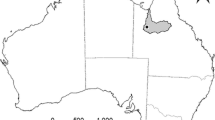Abstract
Benefit/cost methodologies are well accepted for project analysis from a national perspective. Recent pressure to develop local decisionmaking and local funding for water projects has focused attention on the regional costs and benefits of such development. This paper examines some methodological issues that emerge as one attempts to estimate these regional costs and benefits. Uncritical use of regional economics procedures and concepts such as input-output analysis and value added to measure the primary and secondary impacts of these projects carries the risk of seriously overestimating regional project benefits. The paper concludes that new approaches to regional project analysis must be developed that will reconcile and incorporate regional economics procedures with benefit/cost methodology.
Similar content being viewed by others
References
Corps of Engineers, “Columbia Basin Water Withdrawal Environmental Review: Appendix C-II-Regional Effects, Portland District.” David M. Dornbusch & Company, Inc., Portland, OR., May 1980.
Findeis, Jill L., and Norman K. Whittlesey. “Competition Between Irrigation and Hydropower Water Use in Washington State.” Pullman, WA.: Report 44, State of Washington Water Research Center, Washington State University, June, 1982.
Gardner, Richard L., and Thomas A. Miller, “Price Behavior in the Water Market of Northeastern Colorado,”Water Resources Bulletin Vol. 19, No. 4, August 1983, pp. 557–562.
Hamilton, Joel R., and R. Ashley Lyman. “An Investigation Into the Economic Impacts of Subordinating the Swan Falls Hydroelectric Water Right to Upstream Irrigation.” Moscow, ID.: Idaho Water and Energy Resources Research Institute, University of Idaho, December, 1983.
Harris, Wesley. “Feasibility and Feasibility Sensitivity of Potential Irrigation Development in Southern Idaho,” Unpublished M.S. Thesis, Department of Agricultural Economics, University of Idaho, May, 1984.
Howe, Charles W.Benefit-Cost Analysis for Water System Planning. Washington, D.C.: American Geophysical Union, 1972.
Howe, Charles W.Natural Resource Economics: Issues, Analysis, and Policy. New York: John Wiley and Sons, 1979.
Howe, Charles W., D. Schurmeier, and L. Shaw. “Innovations in Water Management: Lessons From the Colorado-Big Thompson Project,” Draft Manuscript, Department of Economics, University of Colorado, May 1982.
Kleinman, Alan P., and F. Bruce Brown, “Colorado River Salinity: Economic Impacts on Agricultural, Municipal, and Industrial Users,” Denver: Colorado River Water Quality Office, Bureau of Reclamation, December, 1980.
Marshall, Harold E. “Economic Efficiency Implications of Federal-Local Cost Sharing in Water Resources Development,”Water Resources Research, Vol. 6, No. 3, June 1970.
Olson, Kent W. “The Economics of Interbasin Water Transfers in Oklahoma,”The Southwestern Review, Vol. 3, No. 1, Winter 1983, pp. 101–114.
Powell, Tim, C. Wilson Gray, and Steve Adams. “Crop Enterprise Budgets, District 3,” Cooperative Extension Service, University of Idaho, June 1983.
Young, Robert A., and S. Lee Gray. “Economic Value of Water: Concepts and Empirical Estimates.” Springfield, VA.: National Technical Information Service, PB-210 356, March 1972.
Young, Robert A., and S. Lee Gray. “Input-Output Models, Economic Surplus, and the State or Regional Water Plans,”Water Resources Research, Vol. 21, No. 12, December 1985.
U.S. Water Resources Council, “Economic and Environmental Principles and Guidelines for Water and Related Land Resources Implementation Studies,”Federal Register, U.S. Government Printing Office, March 10, 1983.
Author information
Authors and Affiliations
Rights and permissions
About this article
Cite this article
Hamilton, J.R., Gardner, R.L. Value added and secondary benefits in regional projection evaluation: Irrigation development in the Snake River basin. Ann Reg Sci 20, 1–11 (1986). https://doi.org/10.1007/BF01283620
Received:
Revised:
Issue Date:
DOI: https://doi.org/10.1007/BF01283620




